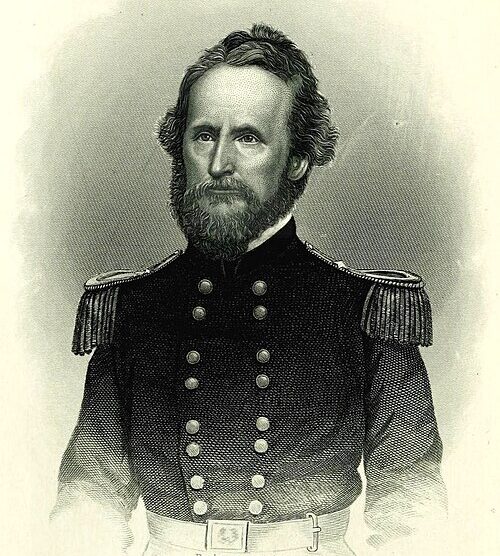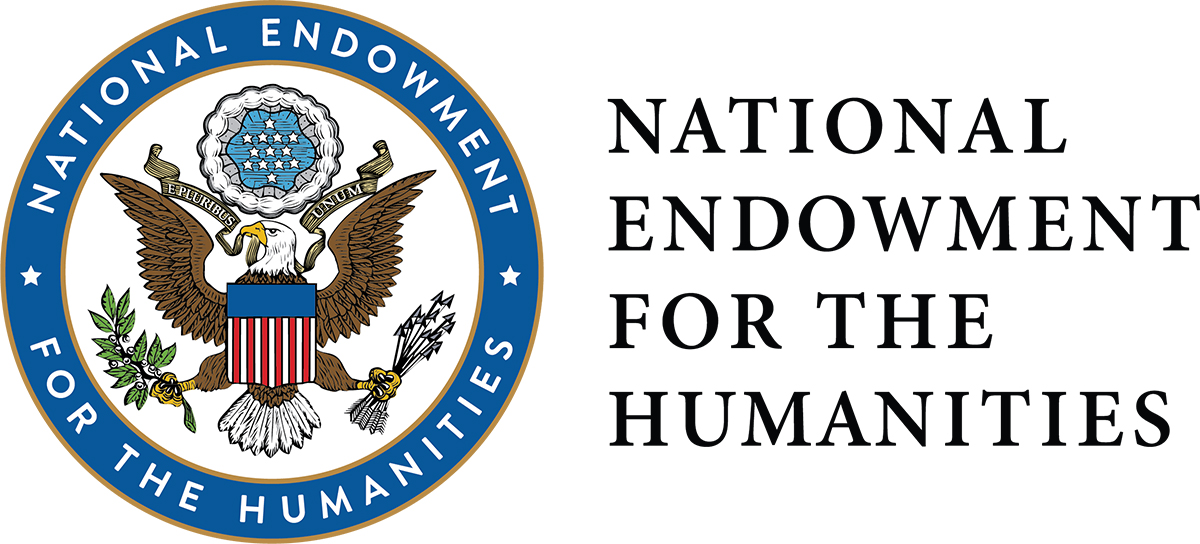By Emma Wiley
Nathaniel Lyon became nationally famous as the first US general killed during the Civil War. As a career soldier, Lyon served in several wars, participated in the massacre of Indigenous people in California, and led troops against proslavery forces in Missouri. Lyon’s death provided one of the first opportunities for national mourning during the Civil War.
Early Life and Education

Political cartoon depicting Nathaniel Lyon chasing Missouri secessionist Governor Claiborne Jackson and General Sterling Price at Boonville, 1861. – By Currier & Ives, Library of Congress. Used through Public Domain.
Nathaniel Lyon was born on July 14, 1818 in Ashford, Connecticut (now part of Eastford) to Amasa Lyon and Kezia Knowlton Lyon. One of seven children, Lyon attended school locally before going to the West Point Military Academy. He graduated in 1841 and was commissioned into the US army as a second lieutenant.
Military Career
Lyon was a career soldier in the US military for most of his adult life. He served in the Second Seminole and Mexican-American wars and afterward was assigned to posts in California. While in California, Lyon participated in state-sanctioned genocides of Indigenous people in the region. In 1850, Lyon-led troops killed a group of Pomo people at Clear Lake, California in what became the Bloody Island Massacre.
As “Bleeding Kansas” began developing, Lyon was sent to Kansas’s Fort Riley. In Kansas, Lyon experienced the growing agitation and violent conflict between antislavery and proslavery settlers.
American Civil War

Print of Battle of Wilson’s Creek – Fall of Genl. Lyon – By F.O.C. Darley and George E. Perine, Missouri Historical Society, Wikimedia Commons. Used through Public Domain.
In February 1861, shortly before the start of the Civil War, Lyon became the commander of the US arsenal in St. Louis, Missouri as a captain. Tensions grew between Lyon’s federal troops and the pro-secessionist Missouri Governor Claiborne Jackson and his supporters. Lyon recruited the support of the St. Louis chapter of the Wide Awakes, many of whom were German-American or German immigrants.
Conflict came to a head during the Camp Jackson Affair on May 10, 1861 when Lyon’s troops surrounded the pro-Confederate Missouri militia that had been gathering at Camp Jackson. As the federal troops marched their prisoners through the city, hostile crowds gathered and Lyon’s troops ended up firing into the crowd. They killed and injured dozens of people, prompting rioting for several days.
Shortly after the Camp Jackson Affair, Lyon was promoted to brigadier general and became the commander of US troops in Missouri. After clashing in numerous skirmishes and battles around the state in pursuit of Governor Jackson and the rest of the Missouri Militia, Lyon’s final battle was on August 10, 1861 at the Battle of Wilson’s Creek. While striking Confederate Brigadier General Ben McCulloch’s troops in a surprise pincer attack, Lyon was shot in the heart and killed. The United States’ loss and subsequent retreat at the Battle of Wilson’s Creek resulted in Confederate control of southwestern Missouri.
A Nation in Mourning

Nathaniel Lyon’s gravesite in Eastford, Connecticut, 2011. – By Morrowlong, Wikimedia Commons. Used through a CC BY-SA 3.0 Unported license.
As the first general from the North killed during the Civil War, Lyon’s death provided an opportunity for national mourning throughout the North as his body traveled back to Connecticut. Soldiers escorted his casket through St. Louis, Pittsburgh, and Philadelphia and Lyon lay in state in both Cincinnati and New York City. Lyon’s body traveled by special train from Hartford to Willimantic and a procession of four hours brought him to the Congregational Church in Eastford.
The Hartford Daily Courant reported that approximately 15,000 people attended Lyon’s funeral and interment at the Congregational Church and Phoenixville Cemetery (now known as General Lyon Cemetery). In addition to the tens of thousands of mourners, numerous dignitaries spoke at the service including Speaker of the US House of Representatives Galusha Grow (originally from Ashford), Connecticut Governor William Buckingham, and Rhode Island Governor William Sprague IV. As the Civil War continued, Lyon’s death continued to be symbolically relevant—an 1861 fort in Virginia was named Fort Lyon and the 24th Missouri Infantry Regiment’s nickname was “The Lyon Legion.”
Emma Wiley is a public historian and the digital humanities content manager at CT Humanities.









